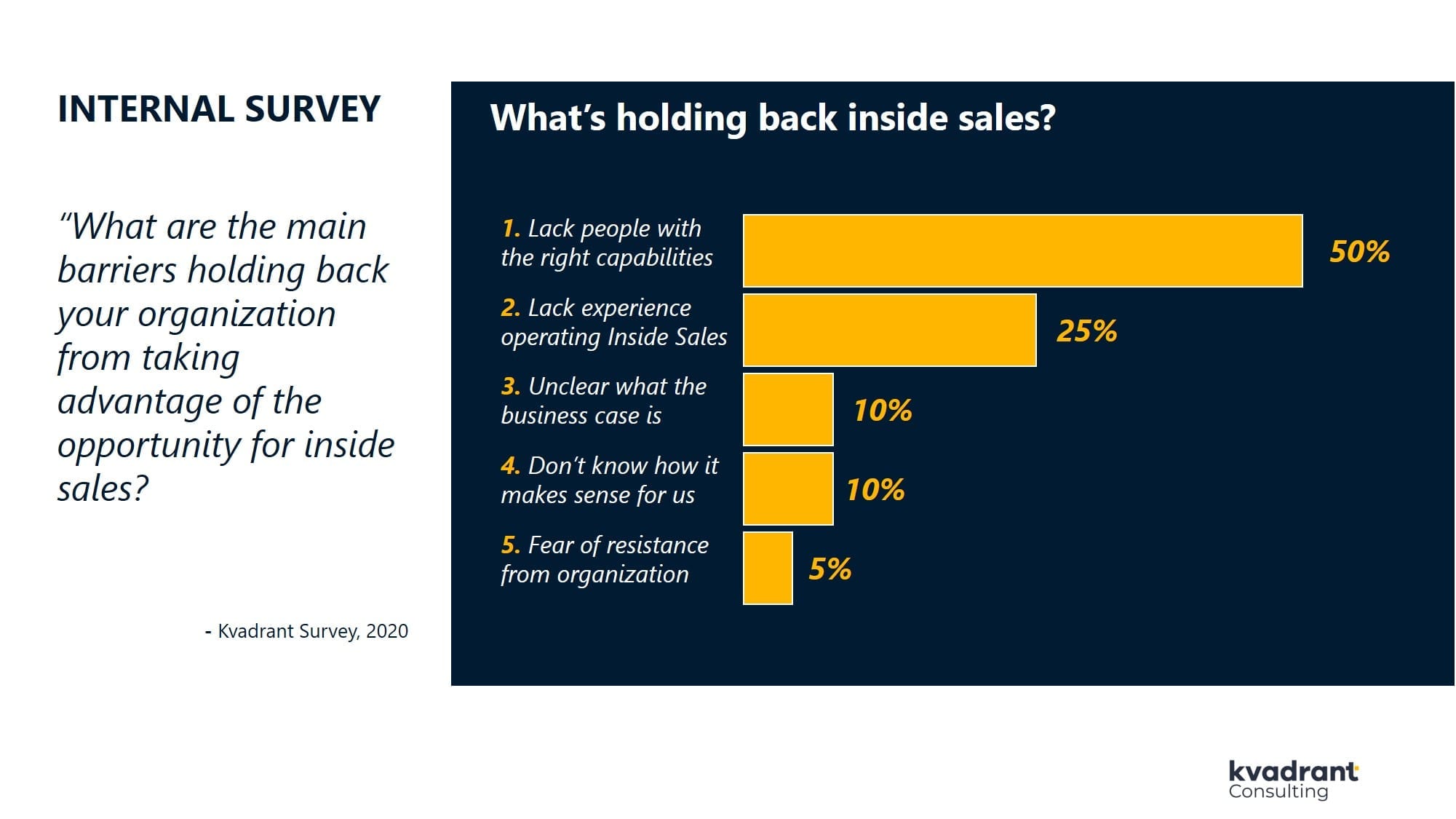Adoption of Inside Sales is growing 15x faster than field sales and the balance between the two is expected to move towards a 50/50 equilibrium in the coming years.
A development that has most likely accelerated due to Covid-19.
In our Commercial Leadership Forum for CxOs of global B2B companies back in March, we asked for their take on the current status of inside sales, where it’s heading and what’s holding back adoption.
The conclusions resonate even stronger in light of what has happened since.
3 key takeaways:
1. Use of Inside Sales relative to field sales expected to increase 48%, to reach ideal sales force mix.
2. 84% believe inside sales could help reduce cost of sales and improve ability to service clients better, but only 7% see inside sales currently being exploited to it’s full potential
3. The greatest barriers to getting more value from inside sales are lack of people with the right capabilities and lack of company experience operating an inside sales function
1. Use of Inside Sales relative to field sales expected to increase 48%, to reach ideal sales force mix.
Exhibit 1
Currently, research reports that among sales professionals in Europe, only 37,1% represent Inside Sales, whereas 62,9% belong to more traditional outside sales roles. [c1] As digitally enabled and empowered buyers more often reject time-consuming face-to-face meetings (in 75% of B2B buying situations, buyers now prefer not to meet face-to-face), many organisations need to reorganise their mix of outside- and inside sellers to avoid becoming redundant.
This is also why the tendency today is, that for every outside sales rep that gets hired, so do ten inside sales reps.[c2]
The vast majority of the commercial executives we talked to, believe that a more balanced mix of Inside Sales and Outside Sales can help them serve clients more successfully and effectively.
2. Strong agreement about potential value of Inside Sales, but only 7% see it currently exploited to its full potential
Exhibit 2

Inside Sales employees has the ability to engage with a larger quantity of potential buyers at a significantly lower cost than outside sales employees.
Depending on the complexity of the sale, the volume of the deal, and customer preferences, Inside Sales can either do the initial work on a deal before making a hand-off to Outside Sales or close the deal entirely itself.
Exhibit 3

Consequently, making up a sales force mix consisting of equal parts of inside- and outside sellers has huge potential as a call made from Inside Sales costs 1/6th of an Outside Sales call.
Furthermore, Inside Sales teams can on average acquire a customer 40-90% [c1] cheaper than what Outside Sales can do.
With all of these advantages, why is it then only 7% of the respondents who fully exploits Inside Sales?
3. Lack of people with the right capabilities and experience operating an inside sales function, biggest barriers to more use of inside sales
Exhibit 4

A common misunderstanding is that ‘Inside Sales’ is just a fancy word for ‘Telemarketer’, why some commercial executives may find it difficult to spot the right talents, while also finding themselves reluctant to pay the wage which attracts the top-shelf inside sellers.
In today’s market, the quantity of open sales positions far outstrips talented candidates, why there is a real competition among organisations to attract the talents. Therefore, executives will first have to recognise the complexity of the Inside Sales role before they can truly succeed with the implementation of such a function.
Companies have two opportunities when finding that they lack people with the right capabilities; they can either
- Train or upskill existing employees or
- Hire new talents.
With the first-mentioned, we often see that organisations have sellers who wish to be less on the road and would appreciate the ability to work more from home. If these have the right set of skills, they may beneficially be trained to fulfil an inside sales function.
If organisations find it necessary to hire, Mark Roberge’s research from his years at Hubspot identify some of the most important characteristics to look for:
- Coachability
- Curiosity & passion
- Work ethic
- Intelligence
- Domain experience & prior success
Exactly who you need to retrain or hire will also depend on the type of inside roles the person is expected to live into
Exhibit 5

Looking at lack of experience in running an Inside Sales function, it is beneficial to find best-practice examples, which can be used as inspiration.
Furthermore, it is critical to secure that the right knowledge is within your transformation team. Either, organisations should use or hire employees who have experience with Inside Sales transformations, and otherwise, they would benefit from seeking help from external experts.
An Inside Sales transformation are pre-set to fail if the right knowledge sources are not secured to run the project. For this reason, it is central in any organisational transformation that expertise in organisational change are brought in the lead the project together with representatives with a deep understanding of the organisation in concern.
Exhibit 6
Get to Minimum Viable Function first and work in short sprints.
There is much talk in the corporate about agile development, rapid prototyping and experimentation. At Vattenfall we decided to put these topics to the test by challenging ourselves to build a new commercial function (in this case an Inside Sales function) in just 10 weeks.
The process followed there is the same we recommend to all commercial leaders, explained in further detail by Vattenfall Network Solutions CEO, Jesper Karpsen:
- Start with a clear hypothesis and business case to test
- Go to “Minimum Viable Function” first, to start testing and learning fast
- Work in short sprints with continuous alignment between stakeholders
- Reach out to others with experience and be inspired



